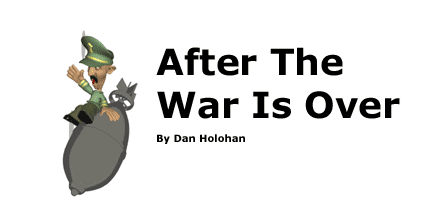One of the treasures that I have in my library is a booklet titled, “Trends in Heating Development” that Coal-Heat magazine published in July, 1942. K.C. Richmond, the Editor of Coal-Heat surveyed a group of people whom he considered industry leaders back then, and this booklet contains their predictions for the future of heating in America after the war. Reading it today is like having a time machine. I know, of course, what is going to happen, but in many cases, so did they, and they didn’t have the benefit of hindsight. Here’s what K. C. Richmond had to say in his introduction.
“Long-time trends in housing, building construction, shortages of materials owing to the war, governmental restrictions, availability of fuel, research, competition, consumer demand – each is contributing to marked changes in heating equipment design, manufacture and distribution.
“Our first job is to help win the war, of course, but that will be done – thanks to our resources in coal, oil, iron, manufacturing facilities and manpower.
“As soon as the war is over, however, a ‘battle-royal’ for the housing, heating and fuel markets can be expected. It is inevitable. Years of neglect of most of the heating equipment in use will result in a tremendous market for repairs, replacement, and modernization. Coupled with the pent-up demand for new housing and the shifts in population, a building boom is anticipated.
“The restrictions under which industry is working will only intensify the competition between the furnace, boiler, stove, and heater outlets – between the coal, oil and gas interests. That there will be no little competition in general for the consumer’s dollar goes also without saying. Some industries will be forced to fight for their survival.
“If we think in terms of human comfort, successful heating becomes inseparable from (a) housing or building construction; (b) the heating system as a whole; (c) the operation and maintenance of the heating facilities. Basically, we must remember that (1) no fuel is any better than the equipment in which it is used; (2) the equipment is no better than the skill of the operator; (3) what happens to the heat after it leaves the boiler or furnace is what counts. Housing and fuel and heating equipment are as inseparable as scrambled eggs. What progress we make is going to depend largely on how we recognize these fundamentals. The day is fast passing when we can ‘get by’ with blind selling.
To find out what the situation is; what we can look for after the war; and how we can prepare to meet the problems that will come up, we recently asked several of the best informed men we know to summarize some of the trends and developments as they see them. Here is what they say.” What follows are 37 brief gems, written by people who really took the time to think things through. I’ve scanned the booklet into the Library at HeatingHelp.com and you can read it in its entirety when you have the time.
One of the writers is W. Walter Timmis, Chief, Plumbing & Heating Branch War Production Board ,Washington D. C. In thinking back on my father’s war, I never considered this. Mr. Timmis’ words:
“Absenteeism is another problem which needs more attention. Sick and injured war workers lose 6,000,000 workdays every month. Over 20 million families have members with colds at one time. Nationally, the average man loses two to four days a year from work due to colds – women twice as much.
“Faulty heating, overheating, wide variations in temperature, exposure, drafts – each contribute to the high incidence of colds. Part of the solution to the problem of absenteeism, colds and ill health, rests in the hands of the coal man, the stoker and heating appliance dealer. Better control of temperature is one of the best means of preventing the common cold.”
Ever think the coal man played such an important part in the war effort?
In 1989, when Marianne and I went into business, a good friend, Dick Koral of the Apartment House Institute (which is part of New York City Technical College), gave me several file cabinets filled with the collection of Clifford Strock, who once edited Heating & Ventilating magazine. I based several of my books on what I found in those files, and along the way, I fell even more deeply in love with the wonderful history of this industry. Dick Koral was Mr. Strock’s Associate Editor for many years, and the files were about to go into the trash because of a lack of space at the college. Dick saved them by giving them to me, and much of that collection is now scanned into the Library HeatingHelp.com. Please help yourself.
Trends in Heating Development was also part of that collection, and Mr. Strock’s handwriting is on the cover. There’s also a handwritten note in the margin of page 27, from Coal-Heat magazine’s K. C. Richmond to Mr. Strock. He penned it next to an opinion written by R. C. Cross, who was in the Engineering Department of Sears, Roebuck and Co. The note reads, “Cliff, you should visit Cross. Did a $70,000,000 plbg & htg business in 1941 – 23,000 stokers. Have probably the country’s best equipped testing lab. Htg industries (sic) post-war competition will come from new concerns – large corporation. New methods of distribution. Middleman and former outlets may be bi-passed (sic).” Prescient, isn’t it? What an amazing business Sears did just before the war began, and Mr. Richmond’s prediction have come true to a certain extent.
Mr. Strock had a section in Trends in Heating Development, and here’s what he had to say. The title of his essay is, “Developments of Great Interest and Value.” He mentions Dr. Abbot’s sun-heat boiler in the third paragraph. That alone is worth a Google search. (This business is so fascinating.)
“It is quite possible that many of the changes in design of heating equipment which will come about in the next three to five years may be those due to a changed fuel situation. The present oil shortage is giving both anthracite and bituminous coal at least a short-term advantage. Oil is temporarily in a tough spot and it is not too improbable that if aviation sharply expands after the war and if refining methods are somewhat altered it may prove unprofitable to burn petroleum products as a heating fuel.
“If some of the legislative questions bothering the utilities are ever cleared up definitely one way or another, perhaps the time will not be too far distant when such organizations will still more actively promote (1) district heating, (2) gas heating, and (3) begin real work on off-peak storage of electrical energy for buildings.
“Perhaps, too, Dr. Abbot’s sun-heat boiler or some similar device may be available for certain uses. Local developments, such as a spread of sawdust burners in wood-producing areas and even alcohol burning in corn-producing areas, may take place.
“Fuel conservation agitation of which we may see more this winter than ever before may possibly have a profound effect in bringing about further adoption of insulation, storm windows and weather-stripping, and this in turn is bound to affect heating design.
“The great interest in radiant heating during recent years may be accentuated; some organizations are working on variations of this with metal foil insulation used to retrain the energy from human beings in the enclosure supplemented by artificial radiant energy in the walls, coupled with absorption of human radiant energy by cool walls in summer.
“High temperature hot water (somewhat misleadingly called high pressure) systems have begun to appear in this country, following their wider use abroad, and this may increase. Work is also reported underway on steam heating boilers using forced circulation to reduce heat transfer surface in the boiler and thus reduce boiler size.
“Whether these or other developments take place, we can be sure of one thing: there will be developments of value and great interest to all of us concerned with heating.”
And there sure were. What’s next?
Dan Holohan



Home › Forums › After the War Is Over